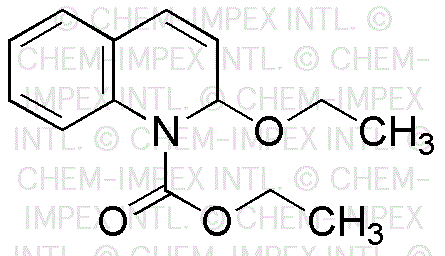N-Ethoxycarbonyl-2-ethoxy-1,2-dihydroquinoline is widely utilized in research focused on:
- Synthesis of Pharmaceuticals: This compound serves as a key intermediate in the synthesis of various pharmaceutical agents, particularly those targeting neurological disorders. Its unique structure allows for modifications that enhance biological activity.
- Organic Synthesis: It is employed in organic chemistry as a building block for creating complex molecules. Researchers appreciate its versatility in forming various derivatives that can be tailored for specific applications.
- Material Science: The compound is used in the development of advanced materials, including polymers and coatings. Its properties can improve the durability and performance of these materials in industrial applications.
- Agricultural Chemistry: It finds applications in agrochemicals, particularly in the formulation of pesticides and herbicides. The compound's effectiveness in targeting specific pests makes it a valuable asset in sustainable agriculture.
- Analytical Chemistry: Researchers utilize this compound in analytical methods, such as chromatography, to separate and identify other chemical substances. Its stability and reactivity provide reliable results in various analytical procedures.
General Information
Properties
Safety and Regulations
Applications
N-Ethoxycarbonyl-2-ethoxy-1,2-dihydroquinoline is widely utilized in research focused on:
- Synthesis of Pharmaceuticals: This compound serves as a key intermediate in the synthesis of various pharmaceutical agents, particularly those targeting neurological disorders. Its unique structure allows for modifications that enhance biological activity.
- Organic Synthesis: It is employed in organic chemistry as a building block for creating complex molecules. Researchers appreciate its versatility in forming various derivatives that can be tailored for specific applications.
- Material Science: The compound is used in the development of advanced materials, including polymers and coatings. Its properties can improve the durability and performance of these materials in industrial applications.
- Agricultural Chemistry: It finds applications in agrochemicals, particularly in the formulation of pesticides and herbicides. The compound's effectiveness in targeting specific pests makes it a valuable asset in sustainable agriculture.
- Analytical Chemistry: Researchers utilize this compound in analytical methods, such as chromatography, to separate and identify other chemical substances. Its stability and reactivity provide reliable results in various analytical procedures.
Documents
Safety Data Sheets (SDS)
The SDS provides comprehensive safety information on handling, storage, and disposal of the product.
Product Specification (PS)
The PS provides a comprehensive breakdown of the product’s properties, including chemical composition, physical state, purity, and storage requirements. It also details acceptable quality ranges and the product's intended applications.
Certificates of Analysis (COA)
Search for Certificates of Analysis (COA) by entering the products Lot Number. Lot and Batch Numbers can be found on a product’s label following the words ‘Lot’ or ‘Batch’.
Número de catálogo
Número de lote/lote
Certificates Of Origin (COO)
This COO confirms the country where the product was manufactured, and also details the materials and components used in it and whether it is derived from natural, synthetic, or other specific sources. This certificate may be required for customs, trade, and regulatory compliance.
Número de catálogo
Número de lote/lote
Safety Data Sheets (SDS)
The SDS provides comprehensive safety information on handling, storage, and disposal of the product.
DownloadProduct Specification (PS)
The PS provides a comprehensive breakdown of the product’s properties, including chemical composition, physical state, purity, and storage requirements. It also details acceptable quality ranges and the product's intended applications.
DownloadCertificates of Analysis (COA)
Search for Certificates of Analysis (COA) by entering the products Lot Number. Lot and Batch Numbers can be found on a product’s label following the words ‘Lot’ or ‘Batch’.
Número de catálogo
Número de lote/lote
Certificates Of Origin (COO)
This COO confirms the country where the product was manufactured, and also details the materials and components used in it and whether it is derived from natural, synthetic, or other specific sources. This certificate may be required for customs, trade, and regulatory compliance.


